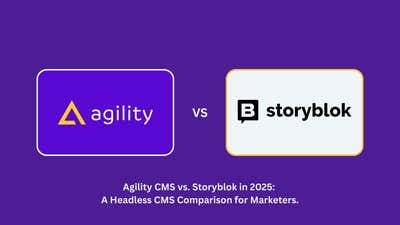A Guide to Agile Marketing for Data and Results-Driven Campaigns
What Is Agile Marketing? And Why your Business needs it.


It’s never been more important as a company to be able to adapt to anything life throws at you. While we might be able to anticipate things like trends in business or our in and outgoings, we are not always able to anticipate things that happen outside of our control.
The biggest example of this in the last year is by far the pandemic. It has forced industries to reshape themselves around new restrictions, reconsider customer needs, and adjust marketing strategies. This, along with the ever-changing technologies now accessible to us, means businesses are often in a state of adaptation and change and need to be able to keep up.
Marketing is essential to any business. It’s how you get your brand known and reach out to your customers; how you build your reputation and constantly improve your conversions. In a business landscape where things need to be flexible, your marketing should be too. This is why many businesses are opting to use agile marketing.
Between 2018 and 2020, adoption increased by 5%, with 42% of marketers now opting to use agile methodology. Agile marketing refers to the flexibility and ‘sprint’ structure used, which can help drive campaigns to deliver higher results.
This article will explore in more detail what the principles of agile marketing are and how it can work for data and results-driven campaigns.
What Is Agile Marketing?

Agile marketing is based on the same principles as agile software development, only it’s applied differently. It acknowledges that we cannot see into the future and that traditional marketing campaigns will likely come across unforeseen obstacles along the way.
While traditional marketing campaigns would stick hard and fast to the plan set out in the beginning, agile marketing allows room for adaptation. It breaks campaigns down into small steps (or sprints) and evaluates success through the data that comes back.
This enables marketers to make adjustments throughout the campaign, to see where they could perform better. By implementing continuous integration, they can regularly adapt and improve their approach. The result is a campaign that’s more flexible and adaptive and provides the desired results.
The Agile Marketing Manifesto
To successfully implement agile marketing strategies, you first have to understand its values - or, as they’re more commonly called, “the manifesto”.
1. Validated learning over opinions and conventions
For data-driven marketing campaigns, this is a value that will sit very comfortably. It’s the principle of always looking at the facts - the data - of how your campaign sprint has performed and learning from this.
In traditional marketing, there’s often a sense of this is how we have always done it - in other words, “if it ain’t broke, don’t fix it”. But while something might work reasonably successfully, it could always be better. By looking for areas of weakness, these can be addressed and improved. Why achieve something OK when you could achieve something great?
2. Customer-focused collaboration over silos and hierarchy
An agile marketing team is structured in a fundamentally different way to a traditional team. It’s not about hierarchy, with the highest-paid person having the final say. It’s a team effort, which focuses on reviewing current data and putting the customer’s needs first instead of conforming to a more hierarchical approach.
This can stimulate a willingness to think outside the box. For example, in marketing, it could be asking yourself whether you stick to traditional forms of advertising, such as TV adverts, or should consider alternative and possibly cheaper customer acquisition strategies that the data demonstrates are more effective.
3. Adaptive and iterative campaigns over ‘big bang’ campaigns
This is the principle of taking smaller steps and evaluating their success along the road. You can see how things are panning out and make adjustments as appropriate. Being adaptive is essential in today’s world. Otherwise, there’s a significant risk your business will be left behind.
You can look at it in the same way you would product testing. For example, mobile application testing requires a prolonged process of checking things over at every stage and debugging. It’s this testing and adjusting that ensures the effectiveness of the app. The same principles can be applied to marketing.
4. The process of customer discovery over static prediction
While some things can be predicted, like the expectation that your customer will want good post purchase customer service, it’s unrealistic to think you can predict a customers' every move, thought, and desire.
Using data to back your decisions gives you greater insight into your customer base and what they need from you. It empowers your company to make smart, logic-based choices when it comes to its marketing strategy, rather than long-term plans based on unsubstantiated presumptions.
Willingness to challenge your perceptions as you discover who your customers are and what they want is essential. The term ‘static prediction’ is important, because that’s exactly what it will bring you: static development i.e. staying in the same place. By adapting, your company can continue to progress.
5. Flexible vs. rigid planning
We’re living in a time when flexibility is a priority, be it in our work schedule or how we approach business. The pandemic has only reinforced the importance of this. Many employers have had to be flexible in adjusting their company to function remotely, and your marketing needs to be capable of adapting to these sudden and unexpected hurdles too.
During the pandemic, many solutions for this issue have been sought. Those who haven't managed a smooth transition have suffered the consequences. It’s perhaps because of this that so many have turned to business continuity planning software to keep everything functioning smoothly.
It’s an attitude of open-mindedness. Returning to the example of software testing, it could be that your attention needs focusing elsewhere in this difficult business landscape, so outsourced software testing is a logical option.
Having the flexibility to adjust your company priorities is essential, and this should be applied to your marketing strategy. It’s asking yourself what strategy is going to work most effectively and efficiently in the present circumstances.
Read a blog post from Agility CMS team: A Wholesome Place to Work. How Agility CMS Handles Work Culture During Pandemic.
6. Responding to change over following a plan
It can be easy to get caught up in what was the agreed plan of action and to be nervous about straying from that path. But planning should be an ongoing process, enabling you to always be prepared no matter what lies ahead.
Industries are developing and changing at a startling rate. For example, when considering an industry like eCommerce, the developments have been phenomenal. In the first quarter of 2021, mobile accounted for 54 percent of all web traffic.
This means that for eCommerce sites to compete, they must be able to adapt across hardware. The way these companies have to make changes and be ‘agile’ is through headless and agile CMS. This means content is user-friendly regardless of the device.
The ability to change and be what the customer needs is essential and can be applied to all areas of the company, particularly its marketing strategy.
7. Many small experiments over a few large bets
To summarise this principle: make sure to cover your bases. Implement several short-term strategies, and proceed with those that are most effective rather than wasting time planning too far ahead in an unpredictable landscape.
8. Using Agile Content Hub: Headless CMS for all your agile marketing content efforts
Headless CMSs come in different forms. Some label themselves as API-first, some as content-first, and many other variations of the headless trend.
The ability to deliver content across multiple channels like smart speakers and smartwatches in the age of IoT is a pivotal part of the equation when it comes to content management. But you can’t forget the needs of content marketers. The marketing teams need robust tools they can rely on and marketer-friendly features that allow them to not only evolve with the growing number of content channels but also grow their websites.
With a traditional CMS, your editors are writing and publishing their content on the back end of the website, the same website that your visitors are viewing. This can be a recipe for disaster since you are unable to preview your changes even before they go live.

Headless CMS, also known as Content as a Service (CaaS) is a cloud-based content-fist approach to content management with a highly configurable and sophisticated architecture. Your content team creates, approves and publishes content that could be used anywhere in your digital ecosystem - website, apps, social, etc. The idea here is that the content isn't intended for a single website page.
Learn more: What Is a Hybrid CMS and Why Do Marketers Love It? | Agility CMS
Putting It Into Practice
Now you need to put these agile marketing principles into practice. An agile marketing strategy is structured on sprints. The team should take work from its backlog and discuss this in sprint planning meetings, prioritizing tasks that needs to be done ASAP.
This work should be focused on to the best of the team’s ability for the next two weeks. This all-in period is known as a ‘sprint’. It’s a shorter period than a traditional marketing campaign and should utilize all of your efforts.
At the end of each sprint, there should be a post-sprint meeting. This is when you turn back to the data, discuss whether the campaign brought the results you were expecting and, if not, how it could/should be changed and improved.
You must collaborate as a team. An agile marketing team is full of equals working toward a common cause, so strong communication skills and mutual understanding are essential.
Case study
Let’s consider a hypothetical case study to see how this works in practice. An eCommerce company selling skincare products is looking to increase its customer acquisition. They’re relying on word-of-mouth and email marketing. This has helped them to build a strong relationship with their current customers but isn’t leading to much growth.
The company doesn’t have the capital to invest in a traditional form of advertising, such as TV, but wants to maximize its marketing strategy’s efficiency. It decides to set up an agile marketing team to discuss its options.
Their goal is to increase the company’s customer base by 10 percent in the next quarter. They hold a meeting and discuss the possible methods of marketing, opting to pursue guest posting, affiliates, and social media adverts.
They initially start small in all three, and after the first two weeks of pursuing these marketing techniques, they look at the data for each example. In this case, blogging has been most successful, while affiliate marketing has been least.
Rather than only pursuing blogging as a marketing technique, the team sits down and discusses what aspects of affiliate marketing are preventing success and how they can make adjustments. Perhaps their affiliates do not successfully represent their brand or the posts are not drawing in customers effectively. This can be adjusted, enabling the marketing team to identify issues quickly and resolve them.
After implementing these changes, the next two weeks are more successful. The post-sprint meeting can, again, take place and see where the team went right this time. Successes can be capitalized on and any residual weaknesses addressed and resolved.
The importance of communication
As you can see above, constant communication is very important to agile marketing. It’s how the team stays aware of the marketing campaign’s performance and develops a plan to improve it.
Agile marketing teams can organize their workload in different ways. Three of the most common approaches are scrum, kanban, and scrumban.
1. Scrum
Like a huddle before a sports game, the scrum approach comes from regular meetings and check-ins throughout the sprint process. It’s a chance for all team members to come together to discuss what work they’re doing and what they plan to do next. This ensures everyone is working cohesively and can be beneficial for keeping team members excited and motivated.
2. Kanban
A kanban board is a workflow visualization tool. It allows a team to input the work that needs to be started, is in progress, and done. This helps the team stay organized and on top of what’s happening throughout the sprint.
As they complete and start tasks, the team physically move them from one section of the workflow chart to the next. This can be a great visual tool in an iterative marketing strategy.

3. Scrumban
A scrumban is what you would expect - a combination of the two above methodologies! It mixes meetings and discussions with a visual aid to monitor workflow and stay on top of it.
Summary
To summarize, it’s clear that agile marketing has a lot of benefits when it comes to data-driven marketing. The frequent reliance on data to make logic-based decisions is essential, and it allows the marketing team to make adjustments to a campaign frequently, as and when this is needed.
This strategy is an opportunity to keep your marketing campaigns current and effective. It’s because of this that so many businesses are opting for this more flexible approach and moving away from the restrictions of traditional marketing.
Will you be among them?
Read more:
7 Tips for Digital Agencies to Stay Agile during the COVID-19 Crisis
How a Headless CMS Can Boost a Marketer's Bottom Line
What is JamStack? A Marketer's Guide to Agile Digital Transformation




